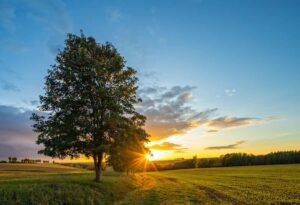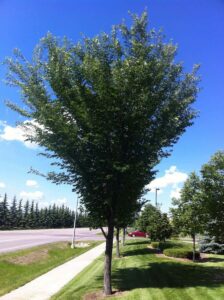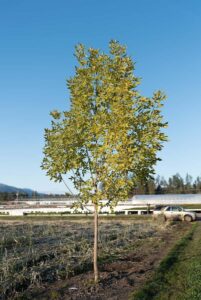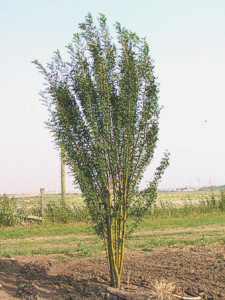Blog
Low-Maintenance Trees for Your Yard
If you want to spend more time relaxing in your yard than working, consider planting native, low-maintenance trees in your back and front yard.
Alberta and British Columbia have many options for trees that are easy to care for, allowing you to personalize your space and enjoy it without too much work. Read on to discover the best low-maintenance trees you can plant to transform your yard into a personal haven.
Shade Trees for the Prairies
With their wide branches and large leaves, shade trees create a cozy place to enjoy the summer weather. These trees shed leaves you’ll have to rake and bag before the winter, but they’re otherwise easy to maintain. Most large shade trees work best in more expansive yards.
- Dropmore Linden (Tilia flavescens ‘Dropmore’). This is the hardiest and most adaptable of the Lindens for Zone 3. They are fast-growing shade trees with pyramid-shaped crowns and heart-shaped dark green leaves that turn bright yellow in the fall. The tree produces fragrant, buttery yellow-white flowers that attract bees in the summer. This linden requires full sun and is resistant to rabbits. This tree is approximately 12 metres tall and 5 – 7 metres wide at maturity. Shop here for Dropmore lindens.
- Brandon Elm (Ulmus Americana ‘Brandon’). This cultivar has a more compact, vase-shaped canopy than other elms. Smaller than its massive cousin, the American elm, it has dark green serrated leaves that turn yellow in the fall. Flowers are insignificant in the spring, but this tree will offer shade and tolerate wet and dry conditions. The Brandon elm is tolerant of road salts and pollution, so it’s an excellent choice for urban areas. This tree can grow to be 15 metres tall with a 10 metre spread, making it more suited to large yards. Shop here for Brandon elms.
- Prairie Spire Green Ash (Fraxinus pennsylvanica ‘Rugby’). These trees grow quickly and have a narrow, pyramidal form, making them an excellent choice for small yards. A seedless variety with green leaves that turn brilliant yellow in fall, these trees grow up to 15 metres, so don’t plant them under power lines. The prairie spire adapts well to various soil types, prefers well-drained soil and is low maintenance. It’s also drought tolerant, and rabbits and deer don’t like it. Shop here for prairie spire green ash.
- Sutherland caragana (Caragana arborescens ‘Sutherland’). Narrow and upright, the Sutherland caragana has green, compound leaves that turn yellow in autumn and a bronze-coloured bark. These trees are suitable for small yards. The tree produces yellow, pea-like flowers that attract bees. The flowers turn into brown pods that pop open and release several seeds. Sutherland caragana is drought tolerant and performs best in sandy, well-drained soil and full sun. Shop here for Sutherland caragana.
- Manchurian ash (Fraxinus mandshurica). Large shade trees with a dense canopy and a distinct oval to round shape. Textured green leaves that turn bright gold in the fall. At maturity, this tree can be more than 12 metres tall with a spread of 6 – 8 metres, so it’s better suited for a larger backyard.
- Laurel leaf willow (Salix pentandra).Fast growing, this is probably one of the best shade trees to plant on the Prairies due to its large, broad canopy. This tree also tolerates wet and dry conditions and can grow to more than 12 metres wide and 12 metres tall, making it more suited to larger yards, acreages and parks. It has narrow dark green leaves that turn yellow in the latter half of fall.
Best Trees For Shade
Some popular options for low-maintenance shade trees to plant in Alberta and British Columbia include:
- Bur Oak (Quercus macrocarpa). This tree can grow up to be massive – roughly 30 metres tall (100 ft.) and 30 metres wide – so it creates ample shade for a large backyard. Its strength allows it to survive more polluted city atmospheres without adverse reactions.
- American Yellowwood (Celtis occidentalis). This tough tree has few problems with insect infestation or plant diseases, so it requires minimal hands-on care. Mature trees grow 15 to 22 metres (50 to 75 ft.) high with a similar-sized foliage spread.
- Red Oak (Quercus rubra). Red oaks grow quickly and are receptive to transplantation. Those qualities make it a great option if you want to enjoy shade right away rather than waiting for your tree to grow from a sapling.
- Tamarack Larch (Larix laricina). It grows slowly and may be only 15 to 18 metres in height. On moist, well-drained soils, however, it can grow to 25 metres. The bark is rough and dark grey, with numerous tiny, reddish winter buds.
- Leaves: Needle-like, 12 to 20 in feather-like clusters, soft and slender, 2 to 4 centimetres long, light green turning bright yellow in the autumn when they fall from the tree. Larches are the only needle-leaved tree to shed needles in the fall.
- Cones: Pollen cones (male) relatively small, yellow; seed cones (female) 1 to 2.5 centimetres. Long, reddish when young, becoming brown and almost spherical when mature; seeds small and winged.
- Distribution: Occurs throughout central and northern Alberta, usually in muskeg and boggy areas. Rarely found in pure stands, it typically occurs in a mixture with black spruce. It can form a component of virtually any type of stand on better sites.
- Wood and Uses: Wood is moderately hard and heavy, somewhat oily, decay resistant, and yellowish brown to reddish brown. It is used for lumber for rough construction, fence posts, poles, railway ties, and pulpwood.
- Lodgepole Pine (Pinus contorta var. latifolia). A tall, slender pine with little taper and a straight trunk; can grow to 30 metres or more in height. It has a thin bark, which is yellowish brown and somewhat scaly.
- Leaves: Needle-like, in bundles of two, produced in dense clusters towards the ends of the branches, 2.5 to 7.5 centimetres long, yellowish green.
- Cones: Pollen cones (male) borne in small terminal clusters; seed cones (female) conical-shaped woody and closed/sealed (serotinous), usually straight, pointed backwards towards the base of the branches, yellowish brown often borne in clusters, 2 to 5 centimetres long, scales thickened and with a sharp spine at the tip of each scale; seeds winged.
- Distribution: The most common and abundant tree in the Rocky Mountains and foothill regions. Occurring on the eastern slopes of the Rocky Mountains where it frequently forms dense even-aged stands resulting from a fire. In areas adjacent to jack pine, the two species integrate.
- Wood and Uses: Wood is moderately light, soft to relatively hard and white to yellowish brown. It is used for lumber and plywood as well as pulp. Lumber is used mainly in general construction, including furniture, siding, flooring and panels. After pressure treatment with preservatives, lodgepole pine makes excellent railway ties, utility poles, and mine timbers.
- Engelmann Spruce (Picea engelmannii). Large tree, sometimes reaching up to 35 metres; the crown is narrow, symmetrical, lower branches usually drooping; bark is thin, scaly, reddish brown.
- Leaves: Needle-like, 4 sided, stiff, 2 to 2.5 centimetres long; bluish green.
- Cones: Pollen cones (male) dark purple, 1.2 to 1.6 centimetres long; seed cones (female) brown to yellowish brown at maturity, 2.5 to 7.5 centimetres long; cone scales broadest near the middle, irregularly toothed on outer edge with prominent bracts; seeds tiny with wedge-shaped wings.
- Distribution: Higher altitudes in high valleys and on slopes of Rocky Mountains in southwestern Alberta. Often mixed with firs, larches, and pines.
- Wood and Uses: Wood is light, soft, resilient, straight grained and white in colour. It can be used for pulp and lumber.
- White Spruce (Picea glauca). A large tree reaching up to 45 metres: rough scaly bark, brownish to silvery grey.
- Leaves: Needle-like, four-sided, stiff, sharp-pointed, 2.5 to 3.0 centimetres long, bright green.
- Cones: Pollen cones (male) small, yellow; seed cones (female) usually at the ends of young twigs, drooping and turning brown at maturity, 4 to 5 centimetres long; scales thin, somewhat rounded with smooth margins; seeds with thin wings.
- Distribution: Widespread throughout south-central and northern Alberta, succeeding Aspen poplar and pine in burned over areas.
- Wood and Uses: Wood is light, soft, resilient, straight-grained, and white in colour. In Alberta, it is the main species used for lumber, plywood, and pulp.
- Northwood Red Maple (swamp maple or scarlet Maple). A very hardy selection of the famous red maple from northern Minnesota, this shapely shade tree features brilliant red fall colour and showy red flowers along the branches in early spring, intolerant of alkaline soils.
- Ornamental Features: Northwood red maple has green foliage which emerges red in spring. The lobed leaves turn an outstanding red in the fall. It features showy red flowers along the branches in early spring before the leaves. It produces red samaras in late spring. The furrowed silver bark and brick red branches add an interesting dimension to the landscape.
- Landscape Attributes: Northwood red maple is a deciduous tree with a shapely oval form. Its average texture blends into the landscape, but can be balanced by one or two finer or coarser trees or shrubs for an effective composition. This is a relatively low-maintenance tree and should only be pruned in summer after the leaves have fully developed, as it may ‘bleed’ sap if pruned in late winter or early spring. It has no significant negative characteristics.
- Plant Characteristics: Northwood red maple will grow to be about 15 metres tall at maturity, with a spread of 9 metres. It has a high canopy with a typical clearance of 2 metres from the ground. It should not be planted underneath power lines. It grows at a medium rate and can be expected to live for 80 years or more under ideal conditions.
- Recommendations: Northwood red maple is recommended for accent and shade. This tree should only be grown in full sunlight. It is adaptable, preferring to grow in average to wet conditions, and will even tolerate some standing water. It is not particular as to soil type but has a definite preference for acidic soils and is subject to chlorosis (yellowing) of the leaves in alkaline soils. It is somewhat tolerant of urban pollution.
Fruit Trees to Plant in Alberta and British Columbia
You might not mind a bit of tree-related yard work if it yields a tasty snack when you finish. Many fruit trees are well-suited to Western Canada’s quick-growing seasons. Try planting these low-maintenance varieties:
- Evans Cherry Tree (Prunus cerasus). Unlike many cherry trees, this variety requires no paired tree for cross pollination. Its cherries are sour or sweet and taste delicious in pies.
- Norland Apple (Malus ‘Norland’). This apple tree bears fruit early, so you won’t have to worry about a short growing season ruining your yield. The tree grows to a more manageable size, typically less than 6 metres (20 ft.), for easy pruning and harvesting.
- Saskatoon berry (Amelanchier alnifolia). This tree is native to Alberta and makes an ideal ornamental shrub or hedge. Its fruit that can be eaten fresh, canned or frozen, and it makes excellent juice, wine and desserts.
To find the perfect spot in your yard for a fruit tree, look for an area protected from the wind so blossoms can preserve their petals and yield a good crop. You’ll also want a slightly elevated area with soil that drains quickly. Fruit trees require regular pruning, but you can get help with that task from a tree grooming service.
Ornamental and Flowering Trees
Green is the colour most frequently associated with trees, but many trees blossom with bright-coloured flowers during the spring and transform into warm, leafy wonders during fall. For your backyard, add a pop of colour during spring, summer, and fall with these ornamental and flowering trees.
- Toba or Snowbird Hawthorn (Cragegus x mordensis). This tree produces bunches of small, tight flowers hardy enough to survive early spring freezes. Blooms are either white or pink.
- Showy Mountain Ash (Sorbus decora). An excellent selection for its winter value. This tree, although slower growing, has a more compact, round canopy than other varieties. It’s one of the best trees for small yards. It produces large clusters of white flowers in late spring, turning to clusters of bright red berries that will carry into winter. This tree also has a nice red/orange fall colour. It grows to 6 metres tall and 5 metres wide.
- Ussurien Pear (Pyrus ussuriensis). A larger pear tree with glossy green leaves that turn a vibrant burgundy in the fall. This tree produces an excellent show of white flowers in the spring. Its yellowish/green fruit is also good for canning or eating. It grows to 6 metres tall with a 4 metre spread.
- Thunderchild Flowering Crab (Malus x ‘Thunderchild’). This is one of the most popular ornamental trees. Its powerful show of deep pink flowers in the spring is followed by small dark red fruit. Dark purple leaves turn a deep red in the fall. This tree is 5 metres tall and approximately 4 metres wide. Note, this tree is highly resistant to fire blight.
- Amur Cherry (Prunus maackii). The Amur Cherry is mostly planted for its winter effect value. The bark is a shiny deep bronze colour and can be a nice contrast against the snow. It flowers white in the spring, with insignificant small fruit in late summer. The leaves are green, slightly serrated and turn yellow in the fall. This tree is slower growing and can reach 8 metres in height and 5 metres across.
Trees for Easy Watering
Perhaps you want to enjoy the view of a tall tree outside your kitchen window without worrying about how frequently to turn on the sprinklers—or without having to install sprinklers at all. In that case, YardSmart trees are your best bet.
YardSmart trees grow well in Canada’s short summers and harsher winters. After a few years of growth, they can survive on rainfall alone. The City of Calgary has prepared a list of YardSmart trees.
Prepare Your Yard for Low-Maintenance Trees
Now that you know the best low-maintenance trees for your yard, you’re almost ready to head to the nursery. Before you choose trees, you should evaluate your current landscaping. Identify trees you want to keep but that might need reshaping or pruning. Also, decide on trees and tree stumps that you’d like removed.
At ArborCare®, our team of dedicated professional arborists can help you select the perfect low-maintenance tree and help you design your backyard oasis.
Tree Planting in Calgary, Edmonton, Kelowna and Winnipeg
When you finalize your new yard, visit ArborCare’s online store and select the trees that’ll become part of your landscaping for years. Our landscape and plant management services provide ongoing care for your trees and shrubs. Let us handle your tree care so your yard becomes a place to relax, not work. Contact us today to get a quote or schedule a consultation
 1-877-444-8733
1-877-444-8733



